|
Running Like Clockwork
by
Bob Brooke
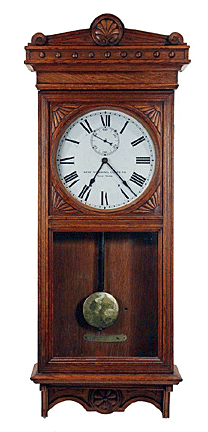 Letís
face it. Without clocks, there would never have been railroads. When
they first appeared, railroads operated at whatever time it happened to
be wherever they were. Distances were incredibly short, so the passage
of time didnít matter. But as the distances got longer and trains
speeded up. Time, or the regulation of time, began to matter a lot. Letís
face it. Without clocks, there would never have been railroads. When
they first appeared, railroads operated at whatever time it happened to
be wherever they were. Distances were incredibly short, so the passage
of time didnít matter. But as the distances got longer and trains
speeded up. Time, or the regulation of time, began to matter a lot.
Before the arrival of the railways, journeys between the larger cities
and towns could take many hours or days, and these differences could be
dealt with bycoach passengers adjusting their hands of a watches
periodically along the way.
One of the first reported incidents which brought about a change in how
time was organized on railways in the United States occurred in New
England in August 1853. Two trains heading towards each other on the
same track collided as the train guards had different times set on their
watches, resulting in the death of 14 passengers. Railway schedules were
co-ordinated in New England shortly after this incident. Numerous other
collisions led to the setting up of the General Time Convention, a
committee of railway companies to agree on scheduling.
Time is a critical factor in railway operations. Safe train movement and
success of the growing railroads depended on keeping time consistently
and accurately. In addition to establishing Time Standards, the railroad
installed a Standard Clock in major stations. Clocks designated as a
Standard Clock were high quality pendulum regulators maintained to
strict standards to ensure they remained accurate.
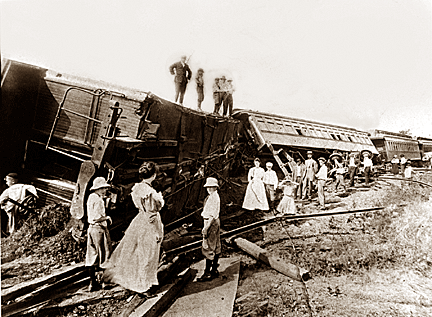
Ensuring the use of consistent standardized time by railroad workers who
were responsible for the movement of trains, when leaving a station and
while the train was moving, was critical to safe railroad operation.
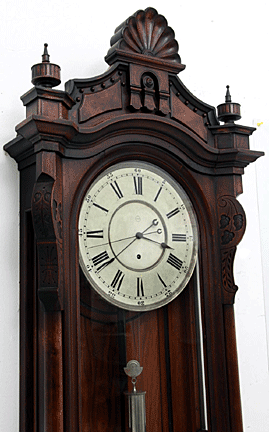 Once
trains became a popular mode of transportation, the railroads needed a
way to avoid collisions between trains and to move trains efficiently
over the railroad lines. A timetable was a published schedule of the
movement of trains which lists the trains, locations along the railroad
line, and times at which certain events, such as arrivals and departures
at a station or siding, to take place. Once
trains became a popular mode of transportation, the railroads needed a
way to avoid collisions between trains and to move trains efficiently
over the railroad lines. A timetable was a published schedule of the
movement of trains which lists the trains, locations along the railroad
line, and times at which certain events, such as arrivals and departures
at a station or siding, to take place.
The Great Western Railway in England first introduced Railroad Time in
1840, when it synchronized a number of different local times and applied
and a single standard time.
By introducing standard railway time, the railway sought to overcome the
confusion caused by having non-uniform local times in each town and
station stop along the expanding railway network and to reduce the
incidence of accidents and near misses, which were becoming more
frequent as the number of train journeys increased.
Railway companies often faced resistance from local townspeople who
refused to adjust their public clocks to bring them into line with
London Time. As a consequence, two different times would be displayed
and in use in a town. Station clocks and the times published in train
timetables differed by several minutes from that on other clocks.
Standard Regulator Clocks
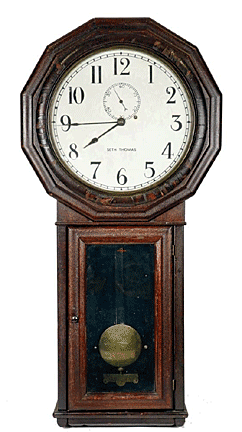 Meanwhile,
across the Atlantic Ocean in the United States, the Baltimore & Ohio
Railroad issued a rule in 1843, stating "the clock at the Pratt Street
depot in Baltimore shall be taken to be the standard time, and all
conductors of passenger trains before departing from Baltimore with
their trains, are required to have their watches regulated with that
clock." The railroad further instructed its conductors to see that all
other stations which they pass conform to the standard time and report
any differences to headquarters. Meanwhile,
across the Atlantic Ocean in the United States, the Baltimore & Ohio
Railroad issued a rule in 1843, stating "the clock at the Pratt Street
depot in Baltimore shall be taken to be the standard time, and all
conductors of passenger trains before departing from Baltimore with
their trains, are required to have their watches regulated with that
clock." The railroad further instructed its conductors to see that all
other stations which they pass conform to the standard time and report
any differences to headquarters.
In July 1853 several rail lines stretching 298 miles from Buffalo to
Albany were consolidated as the New York Central Railroad. The New York
Central officials adopted a single operating time, the "Standard of
Time" given by the "clock in the Depot at Albany."
In addition to the standard time of station clocks, the railroads
required all train dispatchers, conductors, engineers, brakemen,
yardmasters, and foremen of yard engines to equip themselves with
approved railroad watches. It was also critical to verify that each
watch displayed the correct time.
Standard Clocks Synchronized using a
Telegraph Signal
Use of the telegraph improved the consistence of time at railway
stations. William Bond & Son of Boston, started using telegraphed time
signals from the Harvard College Observatory in Cambridge to provide
authoritative time signals to the Boston area railroads beginning in
1851. A similar service began in New York around the same time.
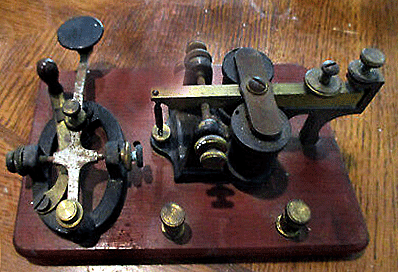 On
Sunday, November 18, 1883, nearly all railroad companies adopted the
Standard Time System, which divided the United States and Canada into
five time zones. At 12 Noon, the stationmaster at each railroad station
was to reset the clock as Standard-Time Noon occurred within each time
zone. And as the telegraph transmitted Greenwich Mean Time (GMT), the
U.S. Naval Observatory began signaling the new time standard. On
Sunday, November 18, 1883, nearly all railroad companies adopted the
Standard Time System, which divided the United States and Canada into
five time zones. At 12 Noon, the stationmaster at each railroad station
was to reset the clock as Standard-Time Noon occurred within each time
zone. And as the telegraph transmitted Greenwich Mean Time (GMT), the
U.S. Naval Observatory began signaling the new time standard.
In order to ensure these standard clocks were always correct, a time
signal was transmitted by telegraph once every 24 hours, using the
resources of the U.S. Naval observatory. The correction signal took the
form of a string of dots at one second on, one second off intervals and
was transmitted via Morse telegraphy for three minutes prior to the hour
at 12 Noon. EST. A 10-second silent period followed this, then a dash at
precisely 12 Noon. Thus, station agents could spike, or correctly set,
the clocks at their location. If a clock differed from the correct time
by less than 10 seconds it was common practice for an agent to place an
indicator card on the clock indicating the variation from correct
Standard Time. When the variation was 10 seconds or more. The agent had
to reset the clock.
Major Regulator Clock Makers
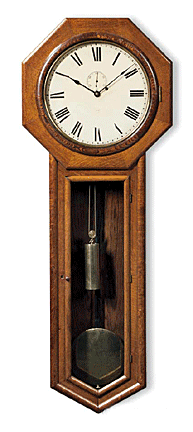 Regulator
clocks first appeared in 1860. Weight driven regulator clocks
manufactured by the Seth Thomas Clock Company seem to have been the most
popular choices when the railroad companies installed Standard Clocks.
The Seth Thomas Regulator No 3 which featured a 14 inch dial and 41 to
44 inch tall case, was widely used as the Standard Clock in the railroad
stations across North America. Larger railroad stations in principle
cities often used larger models with more elaborate cases, such as Seth
Thomas Regulator No 18, height 54 inches, Seth Thomas Regulator No 16,
height 75 inches with a 12 inch dial, or Seth Thomas Regulator No 19,
height 75 inches with a 12 inch dial and a mercury pendulum. The smaller
Seth Thomas Regulator No. 2 with a 12 inch dial and a 36 inch tall case,
was a popular railroad station and office clock. The company continued
to produce the Regulator No. 2, with very few changes, from the early
1860's until 1950 and thus itís probably the longest produced single
model in clock manufacturing history. Smaller Seth Thomas clocks could
be found in railroad offices, locomotives, and business cars. Regulator
clocks first appeared in 1860. Weight driven regulator clocks
manufactured by the Seth Thomas Clock Company seem to have been the most
popular choices when the railroad companies installed Standard Clocks.
The Seth Thomas Regulator No 3 which featured a 14 inch dial and 41 to
44 inch tall case, was widely used as the Standard Clock in the railroad
stations across North America. Larger railroad stations in principle
cities often used larger models with more elaborate cases, such as Seth
Thomas Regulator No 18, height 54 inches, Seth Thomas Regulator No 16,
height 75 inches with a 12 inch dial, or Seth Thomas Regulator No 19,
height 75 inches with a 12 inch dial and a mercury pendulum. The smaller
Seth Thomas Regulator No. 2 with a 12 inch dial and a 36 inch tall case,
was a popular railroad station and office clock. The company continued
to produce the Regulator No. 2, with very few changes, from the early
1860's until 1950 and thus itís probably the longest produced single
model in clock manufacturing history. Smaller Seth Thomas clocks could
be found in railroad offices, locomotives, and business cars.
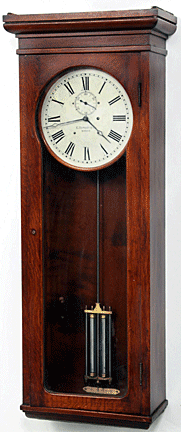 Founded
in 1842 in Roxbury, Massachusetts, under the name Howard and Davis, the
E. Howard Clock Company also manufactured weight-driven regulators of
fine quality. Many railroads used these clocks in their stations because
of their accuracy Founded
in 1842 in Roxbury, Massachusetts, under the name Howard and Davis, the
E. Howard Clock Company also manufactured weight-driven regulators of
fine quality. Many railroads used these clocks in their stations because
of their accuracy
The large Regulator No. 89, with a 12 inch dial and 65 inch tall case,
Regulator No. 57, with a 14 inch dial and 74 inch tall case, and
Regulator No. 60, with a 14 inch dial and 80 inch tall case were used in
larger stations. Regulator No. 70, with a 12 inch dial and a 32 inch
tall case was a commonly used model for smaller stations and offices.
Around 1890, a third company, the Self Winding Clock Company of
Brooklyn, New York, began offering regulator clocks wound by a small
electric motor. The company also offered a mechanism that would
automatically correct any variance from Standard Time using a time
signal over a telegraph line from the US Naval Observatory. When the
Self Winding Clock Company started producing these clocks, the Seth
Thomas Clock Company provided the majority of the clock movements. E.
Howard & Company supplied the remainder. The SWCC appears to have been
manufacturing their own clock movements by 1892. Larger rail depots
often had less expensive "slave" clocks that could be electrically
synchronized with a "master" clock which electrically corrected any
variance on all clocks every hour.
<
Back to Antiques Archives
Next Article > |
